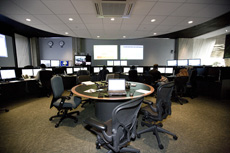CMS detector completes cosmic practice runs
 |
| CMS staff take a shift in the Remote Operations Center. |
Experimentalists at the CMS detector are using the downtime before the Large Hadron Collider is back up and running to get in some exercise.
Researchers used the detector to record data from more than 355 million cosmic events during four weeks in October and November. This was the longest test run with the magnetic field on.
"Since everything was in place, we could really show the whole detector working together," said Ian Fisk, deputy manager for CMS software and computing. "It's a very complicated system, and what you're looking for is to understand its behavior."
Cosmic rays that constantly pass through the earth activate triggers in the detector's sensors just as particles scattered by a collision would do. By tracing their paths and noting the amount of energy the detector records without the presence of beam, researchers can calibrate the detector and better learn how to read it.
"You look for the same things you would if you had beam," said Dave Mason, a Fermilab postdoc.
But, if you see peaks without the beam operating, you know you need to work on eliminating background interference, Mason said.
Researchers used the test run to find and fix foibles in the detector, said Kaori Maeshima, U.S. CMS operations coordinator working at Fermilab.
"There was nothing really bad, no show-stoppers," she said. "But we learned lots of useful things." They discovered, for example, that ambient light in the collision hall affected one component of the detector. This was fixed.
The run also exercised the LHC Computing Grid, which will process and distribute the vast amount of data that the LHC will collect once at full power. All of CMS's Tier-1 centers, including Fermilab, received the data, along with some Tier 2s and at least one Tier 3.
The CMS collaboration plans to conduct more cosmic runs in the next several months.
-- Kathryn Grim
|